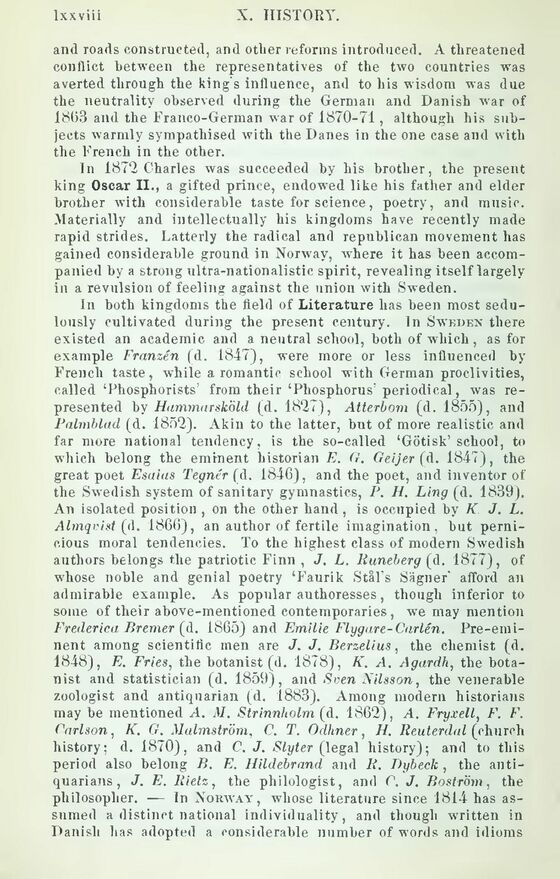
Full resolution (JPEG) - On this page / på denna sida - Introduction - Pages ...

<< prev. page << föreg. sida << >> nästa sida >> next page >>
Below is the raw OCR text
from the above scanned image.
Do you see an error? Proofread the page now!
Här nedan syns maskintolkade texten från faksimilbilden ovan.
Ser du något fel? Korrekturläs sidan nu!
This page has never been proofread. / Denna sida har aldrig korrekturlästs.
and roads constructed, and other reforms introduced. A threatened
conflict between the representatives of the two countries was
averted through the king’s influence, and to his wisdom was due
the neutrality observed during the German and Danish war of
1863 and the Franco-German war of 1870-71, although his
subjects warmly sympathised with the Danes in the one case and with
the French in the other.
In 187*2 Charles was succeeded by his brother, the present
king Oscar II., a gifted prince, endowed like his father and elder
brother with considerable taste for science, poetry, and music.
Materially and intellectually his kingdoms have recently made
rapid strides. Latterly the radical and republican movement has
gained considerable ground in Norway, where it has been
accompanied by a strong ultra-nationalistic spirit, revealing itself largely
in a revulsion of feeling against the union with Sweden.
In both kingdoms the field of Literature has been most
sedulously cultivated during the present century. In Sweden there
existed an academic and a neutral school, both of which, as for
example Franzén (d. 1847), were more or less influenced by
French taste, while a romantic school with German proclivities,
called ‘Phosphorists’ from their‘Phosphorus’periodical, was
represented by Hammarsköld (d. 18*27), Atterbom (d. 1855), and
Palmblad (d. 1852). Akin to the latter, but of more realistic and
far more national tendency, is the so-called ‘Götisk’school, to
which belong the eminent historian E. G. Geijer (d. 1847), the
great poet Esaias Tegnér (å. 1846), and the poet, and inventor of
the Swedish system of sanitary gymnastics, P. H. Ling (d. 1839).
An isolated position , on the other hand , is occupied by K J. L.
Almqvist (d. 1866), an author of fertile imagination, but
pernicious moral tendencies. To the highest class of modern Swedish
authors belongs the patriotic Finn , J. L. Runeberg (d. 1877), of
whose noble and genial poetry ‘Faurik Stil’s Sägner’ afford an
admirable example. As popular authoresses, though inferior to
some of their above-mentioned contemporaries, we may mention
Frederica Bremer {d. 1865) and Emilie Flygare-Carlén.
Pre-eminent among scientific men are J. J. Berzelius, the chemist (d.
1848), E. Fries, the botanist (d. 1878), K. A. Agardh, the
botanist and statistician (d. 1859), and Sven Nilsson, the venerable
zoologist and antiquarian (d. 1883). Among modern historians
may be mentioned A. M. Strinnholm (d. 1862), A. Fryxell, F. F.
Parison, K. G. Malmström, C. T. Odhner, H. Reuterdal (church
history; d. 1870), and C. J. Slyter (legal history); and to this
period also belong B. E. Hildebrand and R. Bybeck , the
antiquarians, J. E. Rielz, the philologist, and C. J, Boström, the
philosopher. — In Norway, whose literature since 1814 has
assumed a distinct national individuality, and though written in
Danish has adopted a considerable number of words and idioms
<< prev. page << föreg. sida << >> nästa sida >> next page >>